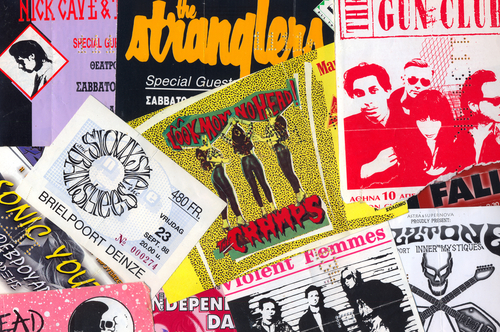Disrupting Ticketing With Digitization

There is no shortage of ways to buy and sell tickets to live events on the Web through the magic of the Internet. With few exceptions, there are very few events that one cannot capture a ticket to with a working Internet connection and a willingness to pay.
And that willingness will often have to be high. For example, to see the Mets play the Cubs in Game 2 of the NLCS will cost a minimum of $112 — and that is a standing room only seat (the bad part). It’s also a bargain; to stand and watch Game 3 at Wrigley Field in Chicago costs a minimum of $202.
But with enough enthusiasm (like for seeing the Cubs break the curse), buying and selling isn’t a problem. Receiving, on the other hand, can be a huge hassle, particularly if one is reselling or re-buying tickets Because things take turn for the surprisingly anachronistic if a ticket’s original buyer has a paper ticket. Because in the realm of an event ticket, what is paper generally must stay paper — and if you want to transfer it, FedEx is probably going to need to be involved.
These days, shipping is fast, and in general a new buyer can have their tickets within a day or so of ordering, which works just fine if the buyer knows a few days out that they definitely want tickets to a particular game or show. But if an insuppressible desire to go to a sold out show strikes the day of the event, there have been basically two options available until now.
The first was the tried and true classic of showing up at the venue and paying the inevitable scalper whatever he asks and then hoping the tickets are legitimate. The second was quiet acceptance and a hope that the show you’re missing ends up on the tour DVD later.
But Tanisha Robinson, co-founder of TicketFire, thinks that in the mobile and digital age, event ticketing should not be about paper at all.
The app is a pretty simple piece of patent-pending tech. With a smartphone camera a user can take just about any live ticket — for a concert or a sporting event or what have you — and snap a photo of it. TicketFire then takes over , scans it into a digital ticket at which point the user can do as they wish with it.”
Because when it comes to airline tickets, or even buying tickets directly, it is already a fairly digital world out there.
“Do you remember the last time you had to print a boarding pass? I don’t,” Robinson noted.
The ticket, once scanned into TicketFire, gets a unique ID that can’t be copied — and a barcode that can be read at any Ticketmaster venue (which represents about 90 percent of all sporting and concert event locals). This means that a user can’t sell multiple copies of a ticket within the system – though it would make it theoretically possible for a user to keep (and try to use) a ticket that they had already sold a copy of.
“Yes, that can happen, but the existing infrastructure also lets that happen. Someone could also print multiple copies of their PDF download of their ticket and sell them on Craigslist,” Robinson said. “And venues have a response for that situation; they toss everyone but the person with the original receipt for the event. We’re a worse venue for fraud because you have to login, upload the ticket and sell it — that’s leaving a much more involved paper trail than just selling a copy on Craigslist.”
And that is a tracking ability, Robinson noted, that can only be enhanced by a greater, formal partnership with Ticketmaster, which is something the firm is currently trying to make happen.
“Most ticketing startups are focused on competing with Ticketmaster. ,” Robinson noted
TicketFire, on the other hand, wants to work with Ticketmaster to upgrade the totality of ticketing into the digital age.
TicketFire is just a marketplace, Robinson noted, which means they only offer a space where tickets are easy to digitize and trade. Pricing is at the discretion of the sellers and what buyers are willing to bear. It also offers ticket holders a unique opportunity to sell tickets for an event already in progress.
“The other thing that we think is cool is that because the ticket window can stay open it ‘s actually possible to buy tickets when you’re inside the venue already. So you could upgrade seats. This would allow sellers of tickets to say ‘this game is already halfway finished, and if I can get $50 for these great seats I’ll do it. So it’s actually possible to upgrade your seats from inside the venue, because you can move those tokens around.”
Until earlier this month, TicketFire was a marketplace with a pretty notable shortcoming: payments. TicketFire didn’t have the ability to take them, meaning buyers and sellers had to rely on third-party platforms to actually finish off the transaction. In early October, TicketFire released Pic-to-Sell, which allows for payments directly in the app, as well as an option for buyers to donate the price to charity (if the seller chooses to open up that as a payment option).
“Since our mobile app went live last year, we have helped tens of thousands of ticket holders in hundreds of countries digitize any kind of ticket and then digitally transfer those tickets at the last minute to another person’s smartphone,” said Dillon Myers, TicketFire COO. “Now our new Pic-to-Sell℠ uses patent-pending scanning technology to make it easy for fans to sell tickets at either a custom or market price, and then turn those tickets into cash or a charitable donation for the ticket holder, even in the days and hours leading up to an event.”
TicketFire is still fairly new to the market. Its app only went into wide release in January 2013, but in a little under two years it has racked up about 80,000 users in 113 countries. With the Pic-to-Sell expansion, which will make actually buying tickets easy for customers, they are hoping to see those numbers tick up even faster.
The competition is fierce when it comes to selling tickets – by most estimates, online ticketing is a $5 billion a year industry, but TicketFire thinks it has simplicity on its side. And on that, it’s hard to argue with them.
